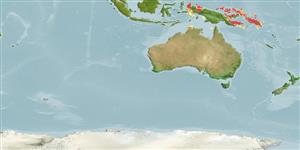>
Clupeiformes (Herrings) >
Spratelloididae (Small round herrings)
Etymology: Spratelloides: Old German, sprotte (1611) = a small fish, Clupea sp. + Greek, suffix, oides = similar to (Ref. 45335).
Eponymy: Dr Anthony David Lewis (d: 1948) is an Australian fisheries biologist and independent fisheries adviser who has joined the International Pole & Line Federation as a trustee (2014). [...] (Ref. 128868), visit book page.
Issue
The species in the genera Spratelloides Bleeker, 1851 and Jenkinsia Jordan & Evermann, 1896 should most probably be assigned to a separated family from Clupeidae and Dussumieriidae (Lavoué, pers. comm., July 2013). See a preliminary analysis in Lavoué et al. (2013: Ref. 93878).
Environment: milieu / climate zone / depth range / distribution range
Ecologia
marinhas; intervalo de profundidade 0 - 50 m (Ref. 188). Tropical; 2°N - 12°S, 130°E - 164°E (Ref. 188)
Western Central Pacific: Solomon Islands, Papua New Guinea, and off Irian Jaya.
Tamanho / Peso / Idade
Maturity: Lm ? range ? - ? cm
Max length : 6.0 cm SL macho/indeterminado; (Ref. 188)
Espinhos dorsais (total) : 0; Raios dorsais (total) : 12 - 13; Espinhos anais: 0; Raios anais : 11 - 12. Distinguished from other species mainly by the silver band on the flanks which fades anteriorly (at about tips of pectoral fins). Maxilla toothed, triangular pre-maxillae, 2 supra-maxillae, second supra-maxilla asymmetrical (lower part larger than upper); vertical striae on scales not meeting at center; W-shaped pelvic scute.
Usually an inshore schooling species. More data needed. Used as bait in the tuna fishery. Found in coastal waters, sometimes forming large active schools at surface near reefs (Ref 90102).
Ciclo de vida ou comportamento de acasalamento
Maturidade | Reprodução | Desova | Ovos | Fecundidade | Larvas
Whitehead, P.J.P., 1985. FAO Species Catalogue. Vol. 7. Clupeoid fishes of the world (suborder Clupeoidei). An annotated and illustrated catalogue of the herrings, sardines, pilchards, sprats, shads, anchovies and wolf-herrings. FAO Fish. Synop. 125(7/1):1-303. Rome: FAO. (Ref. 188)
Status na Lista Vermelha da UICN (Ref. 130435: Version 2024-2)
Ameaça para os humanos
Harmless
Uso pelos humanos
Pescarias: pesca de subsistência; isca: usually
Ferramentas
Relatórios especiais
Baixar XML
Fontes da internet
Estimates based on models
Preferred temperature (Ref.
123201): 28.2 - 29.1, mean 28.8 °C (based on 16 cells).
Índice de diversidade filogenética (Ref.
82804): PD
50 = 0.5625 [Uniqueness, from 0.5 = low to 2.0 = high].
Bayesian length-weight: a=0.00525 (0.00301 - 0.00914), b=3.14 (2.99 - 3.29), in cm total length, based on LWR estimates for this species & (Sub)family-body (Ref.
93245).
Nível Trófico (Ref.
69278): 3.0 ±0.0 se; based on diet studies.
Resiliência (Ref.
120179): Elevada, tempo mínimo de duplicação da população menor que 15 meses (K=4.30-8.90; tm=0.3; Fec=887).
Fishing Vulnerability (Ref.
59153): Low vulnerability (10 of 100).
Nutrients (Ref.
124155): Calcium = 2530 [213, 133,283] mg/100g; Iron = 41.7 [3.8, 409.3] mg/100g; Protein = 18.8 [14.4, 23.1] %; Omega3 = 0.227 [0.004, 13.207] g/100g; Selenium = 1810 [23, 107,595] μg/100g; VitaminA = 0.46 [0.00, 53.86] μg/100g; Zinc = 33.4 [4.1, 187.8] mg/100g (wet weight);
